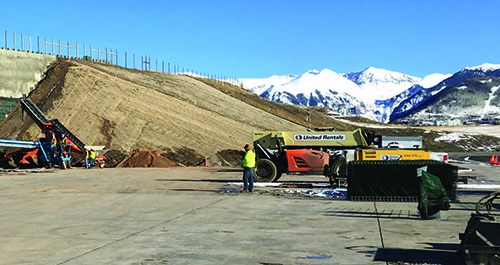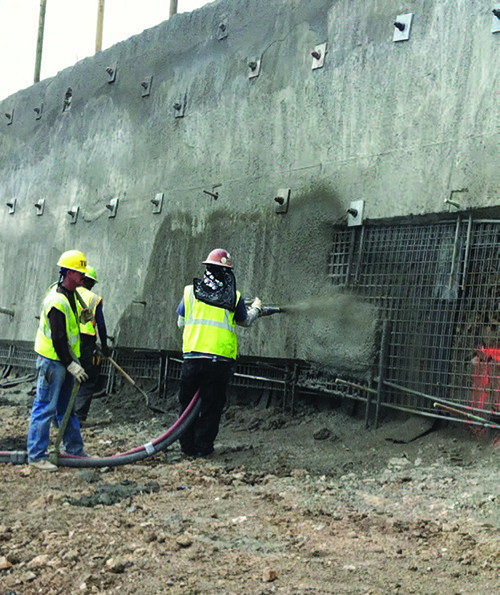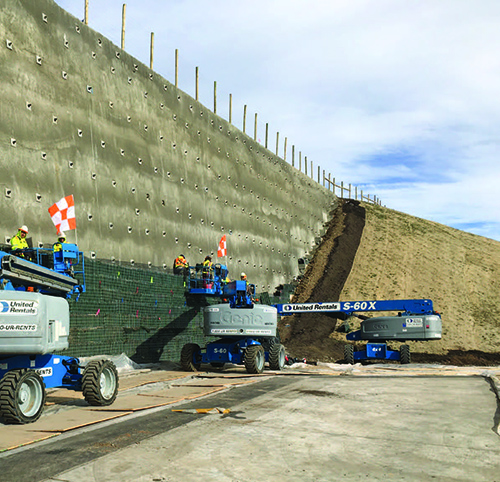Highest-Elevation Airport in U.S. Adds New Deicing Pad

After overcoming space constraints, geological challenges and complications associated with high altitude, Telluride Regional Airport (TEX) in Colorado is thrilled to have a new $7 million deicing pad ready to boost operational efficiency again this winter.
Before the 36,000-square-foot pad was finished last fall, crews deiced aircraft on a concrete parking apron just north of the airport's only runway. "It was right off a taxiway exit connector, so deicing operations could potentially block traffic from exiting the runway on our A taxiway," explains Airport Director Kenny Maenpa. "It was not an ideal situation."
Unfortunately, the airport also lacked an ideal location to add a deicing pad. Located atop Deep Creek Mesa, TEX has a small 542-acre footprint with rolling terrain on both sides of its 7,111-foot runway. "We're pretty limited in terms of flat space," Maenpa comments. And perched at 9,070 feet in Colorado's San Juan Mountains, TEX is the highest-elevation commercial airport in the United States.
The airport's solution: carve out space from a shale hillside on the north side of the runway, near its eastern end. The strategy added considerable cost to the project because it required the construction of a 500-foot-long retaining wall reinforced with devices called soil nails. But given the prevailing space constraints, the improved site proved to be the most logical place to build the new pad. In the end, the pad accounted for only $2.8 million of the total $7 million project cost.
Mountains of Site Challenges
Several other factors also made the project more complicated and expensive than most deicing pad installations. "At altitude, temperatures are low, the construction season is short (typically mid-June through mid-September) and the availability of materials isn't good," says Bob Jones, a project manager for Kimley-Horn, the civil-engineering firm that designed the deicing pad and supervised its construction.
"Procurement and transportation of materials is more difficult," adds Jones, noting that the nearest asphalt supplier was about 90 minutes away.
It's also tough to find general contractors that are willing to work on remote, high-altitude jobs. Moreover, the airport is only open from 6 a.m. to 9 p.m., and construction is not allowed during the night or on Sundays. The restricted work hours are in deference to local homeowners, some of whom live less than one mile from the airport grounds.
To attract a viable number of contractors to the project, the airport opted to forego using a general contractor and split the project into three smaller phases: earthwork and construction of the hillside retaining wall; deicing pad construction/lighting; and installation of a deicing fluid collection system. "Having specialty contractors bid (without a general contractor involved) provides a cleaner way to get a truer, more cost-effective bid," Jones explains. The approach also encouraged broader bid participation, facilitated more streamlined communications, provided the airport better control over the project and resulted in faster construction timelines, he adds.
Local ordinances that govern the aesthetics of constructed elements such as retaining walls added yet another challenge. "There are homes on the south side of the airport that have a view of the airport, and those residents didn't want to see a concrete retaining wall," Maenpa notes. "They wanted something to blend into the surrounding environment."
Terracon Consultants, the geotechnical firm that designed the retaining wall, included a "hanging garden" to make the wall more attractive to the airport's neighbors. About 1,000 wire baskets filled with soil and grass hang from the wall to camouflage its exterior surface, explains Brittany Dalton, a geotechnical engineer.
So far, the arid climate and short growing seasons in Telluride have made growing the grass difficult; but the airport's longtime consultant is working to solve that problem.
 Unstable Terrain
Unstable Terrain
The retaining wall, which stands about 40 feet tall and cost $3.2 million, was a central component of the project. Don Clark, a senior principal/senior consultant at Terracon, explains that several site conditions prompted the need for the wall. For starters, the airport sits on a mesa with a geological fault line running through its center. In addition, the west end of the airport grounds is composed of sandstone, and the east end contains so-called Mancos shale, a weak bedrock formation.
In short, the airport's terrain is rife with unstable geological conditions. TEX officials have dealt with such issues in the past, including a runway embankment failure and 6-foot settlement in the runway. As a result, the runway was completely rebuilt in 2010, followed by a landslide stabilization project on the southeast runway embankment.
"The site poses another unique geotechnical challenge," Clark adds. "Because it's at a high elevation, the airport gets all kinds of snow (about 175 inches per year). When all that snow melts, it creates seasonally high groundwater conditions. When combined with the unique bedrock formations, these factors represent some very unique challenges to do design and construction work-especially with the shale, which creates stability issues."
Given the space constraints, a typical retaining wall-which is built with footings, then backfilled-wouldn't work in the area designated for the deicing pad. Instead, crews had to construct the wall from the top down to stay within the site limits. To do so, workers first excavated the hill in 5-foot-deep sections, called lifts or benches. Then they installed rows of soil nail anchors after each bench excavation to stabilize the shale hillside.
 A soil nail is a long, tension-resistant steel bar that's fixed in place with cement grout. Nail lengths vary from project to project; the key is inserting them past any potential failure zones, as identified by geotechnical analysis. To install the nails, crews first drill 8-inch-diameter holes at a 15-degree downward angle. Then they insert the steel rods and fill the holes with cement grout. The nails reinforce the surrounding soil and also bear the load of a reinforced Shotcrete facing that is applied to the wall after the nails are installed.
A soil nail is a long, tension-resistant steel bar that's fixed in place with cement grout. Nail lengths vary from project to project; the key is inserting them past any potential failure zones, as identified by geotechnical analysis. To install the nails, crews first drill 8-inch-diameter holes at a 15-degree downward angle. Then they insert the steel rods and fill the holes with cement grout. The nails reinforce the surrounding soil and also bear the load of a reinforced Shotcrete facing that is applied to the wall after the nails are installed.
In all, the project required 662 soil anchors, located about 5 feet apart and drilled up to 55 feet deep. "You're basically cutting out the benches and stabilizing things as you go," Clark explains. "Off the top of my head, it's the first time I can recall building this kind of retaining wall at an airport."
A Fluid Situation
To prevent deicing fluid from draining into stormwater sewer lines, the project included a $230,000 collection system designed by Burns & McDonnell. During aircraft deicing operations, excess fluid drains into a 460-foot-long trench drain that is covered with a slotted cast-iron grate. The fluids collect in a 12,000-gallon, underground fiberglass tank
The drain system includes a manually operated on/off valve that prevents melted snow and rain from entering the tank. Crews open the valve during deicing procedures and close it when they're finished. "We don't want any rain getting into that glycol holding tank," Jones notes. An above-ground gauge indicates how full the tank is, and a glycol recycling company periodically pumps out the collected fluids.
 Overall, 90% of the project was funded by the FAA, and the airport and Colorado Division of Aeronautics split the balance.
Overall, 90% of the project was funded by the FAA, and the airport and Colorado Division of Aeronautics split the balance.
"Building the deicing pad was a huge bonus for us, because we no longer lose valuable space for aircraft parking, which is limited here," Maenpa says. "It basically freed up parking for up to four more aircraft, depending on their size."
With about 12,000 annual operations, TEX often has 40 to 60 aircraft land on busy days; so every available space is important.
"It's so nice to have a deicing pad where we can safely deice aircraft and not block any traffic," adds Maenpa. "It's not a very sexy project, but deicing is a very important function at an airport like ours."


 facts&figures facts&figuresProject: Deicing Pad Installation Location: Telluride (CO) Regional Airport Pad Size: 36,000 sq. ft. Capacity: 2 aircraft Cost: $7 million Funding: 90% FAA grant; 5% state; 5% airport Main Components: Retaining wall; deicing pad & glycol collection system Timeline: April 2015 to October 2016 Local Challenges: Small project site with unstable geological conditions; high-altitude location; community aesthetics regulations Deicing Pad Design: Kimley-Horn Deicing Pad Construction: Concrete Works of Colorado Retaining Wall Design: Terracon Consultants Retaining Wall Construction: Hayward Baker Glycol Collection System Design: Burns & McDonnell Collection System Construction: Telluride Gravel Cast Iron Grate Mfg: ABT Problem: Former deicing pad/operations blocked taxiway traffic Key Benefits: New pad improves safety & traffic flow; reclaims aircraft parking spaces |


FREE Whitepaper
PAVIX: Proven Winner for All Airport Concrete Infrastructure
International Chem-Crete Corporation (ICC) manufactures and sells PAVIX, a unique line of crystalline waterproofing products that penetrate into the surface of cured concrete to fill and seal pores and capillary voids, creating a long lasting protective zone within the concrete substrate.
Once concrete is treated, water is prevented from penetrating through this protective zone and causing associated damage, such as freeze-thaw cracking, reinforcing steel corrosion, chloride ion penetration, and ASR related cracking.
This white paper discusses how the PAVIX CCC100 technology works and its applications.








